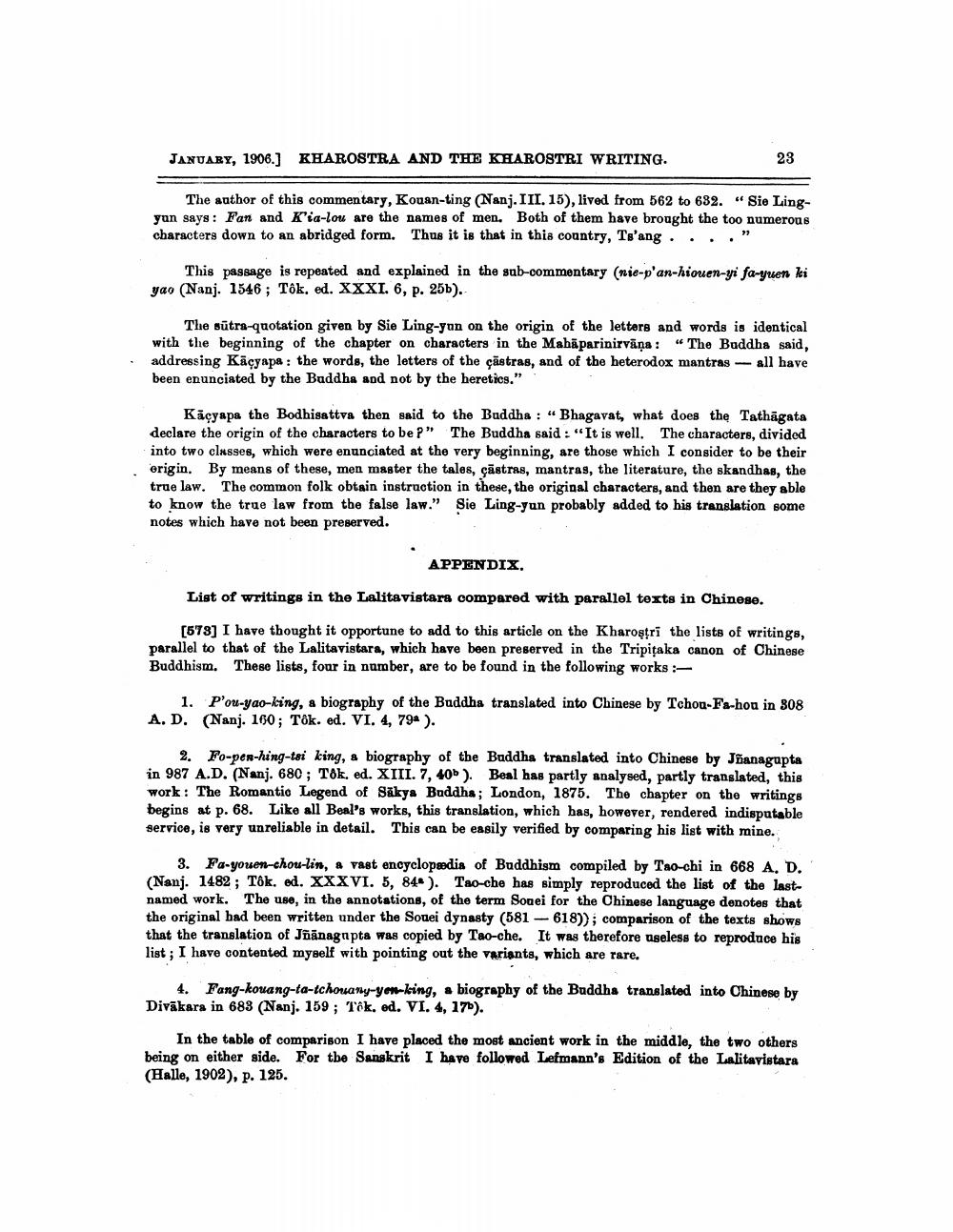________________
JANUARY, 1906.) KHAROSTRA AND THE KHAROSTRI WRITING.
23
The author of this commentary, Kouan-ting (Nanj. III. 15), lived from 562 to 682.“ Sie Lingyun says: Fan and K'ia-lou are the names of men. Both of them have brought the too numerous characters down to an abridged form. Thus it is that in this country, Ts'ang...."
This passage is repeated and explained in the sub-commentary (nie-p'an-hiouen-yi fa-yuen ki yao (Nanj. 1546; Tôk, ed. XXXI. 6, p. 25b).
The sūtra-quotation given by Sie Ling-yan on the origin of the letters and words is identical with the beginning of the chapter on characters in the Mahaparinirvāņa: "The Buddha said, addressing Kāçyapa: the words, the letters of the castras, and of the heterodox mantras -- all have been enunciated by the Buddha and not by the heretics."
Kicyapa the Bodhisattva then said to the Baddha : Bhagavat, what does the Tathāgata declare the origin of the characters to be?” The Buddha said: "It is well. The characters, divided into two classes, which were enunciated at the very beginning, are those which I consider to be their origin. By means of these, men master the tales, cāstras, mantras, the literature, the skandhas, the true law. The common folk obtain instruction in these, the original characters, and then are they able to know the true law from the false law." Sie Ling-yun probably added to his translation some notes which have not been preserved.
APPENDIX.
List of writings in the Lalitavistara compared with parallel texts in Chinese.
[573] I have thought it opportune to add to this article on the Kharoştri the lists of writings, parallel to that of the Lalitavistara, which have been preserved in the Tripitaka canon of Chinese Buddhism. These lists, four in number, are to be found in the following works
1. P'ou-yao-king, a biography of the Buddha translated into Chinese by Tchou-Fa-hou in 808 A. D. (Nanj. 160; Tök. ed. VI. 4, 79a ).
2. Fo-per-hing-tsi king, a biography of the Buddha translated into Chinese by Jñanagupta in 987 A.D. (Nanj. 680 ; Tok, ed. XIII. 7, 406 ). Beal has partly analysed, partly translated, this work: The Romantic Legend of Sākya Buddha; London, 1875. The chapter on the writings begins at p. 68. Like all Beal's works, this translation, which has, however, rendered indisputable service, is very unreliable in detail. This can be easily verified by comparing his list with mine.
3. Fa-youen-chou-lin, & vast encyclopaedia of Buddhism compiled by Tao-chi in 668 A. D. (Nanj. 1482 ; Tok, ed. XXXVI. 5, 84). Tao-che has simply reproduced the list of the lastnamed work. The use, in the annotations, of the term Souei for the Chinese language denotes that the original had been written under the Souei dynasty (581 - 618)); comparison of the texts shows that the translation of Jūānagupta was copied by Tao-che. It was therefore useless to reproduce his list; I have contented myself with pointing out the variants, which are rare.
4. Fang-kouang-ta-tchouany-yen-king, a biography of the Buddha translated into Chinese by Divākara in 683 (Nanj. 159; Tèk. ed. VI. 4, 17).
In the table of comparison I have placed the most ancient work in the middle, the two others being on either side. For the Sanskrit I have followed Lefmann's Edition of the Lalitavistara (Halle, 1902), p. 125.




